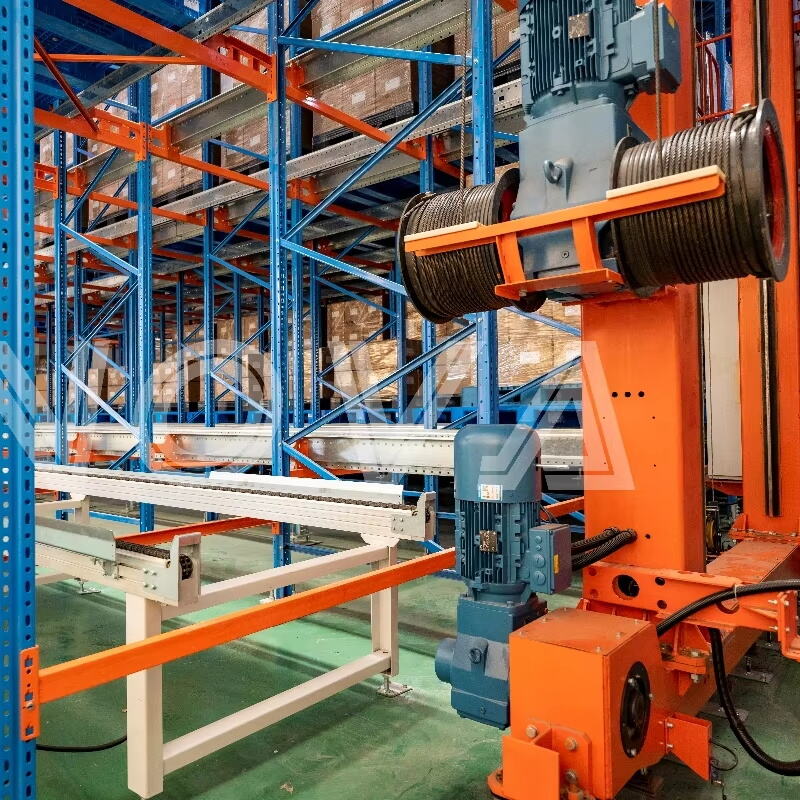At forstå Kinas transportsystemer i logistikautomation
Definition af AS/RS-teknologi i moderne lagerhåndtering
AS/RS-systemer, eller automatiserede lagring- og afhentningssystemer, udnytter robotshuttles godt, hvilket hjælper med at maksimere lagerpladsen i moderne faciliteter. Det, der gør disse systemer unikke, er deres evne til at køre uafbrudt døgnet rundt, hvilket virkelig øger arbejdshastigheden og mængden af varer, der kan flyttes gennem systemet. Kinesiske virksomheder inden for forskellige sektorer har for nylig begyndt at adoptere AS/RS-teknologi, især dem, der beskæftiger sig med e-commerce-opfyldelse og lager af produktionsdele. Ifølge nyeste markedsanalyser viser vækstprognoser, at anvendelsen af AS/RS-systemer i Kina kan stige med cirka 20 procent årligt i årene frem, fordi virksomheder har brug for bedre måder at håndtere deres leveringskæder effektivt. Ud fra, hvad der sker i praksis, ser vi, at lagre nu håndterer langt større ordrevolumener end før, mens de stadig holder stokken korrekt opdateret og reducerer både kravene til gulvplads og behovet for manuel arbejdskraft.
Udvikling af hastesekvens med automatiserede løsninger
Automatiserede udtagningsløsninger har virkelig transformeret, hvor hurtigt ordrer bliver udfyldt, og har gjort lagerfaciliteter meget hurtigere til at tage varer fra hylder. Nogle robotsystemer kan nu tage varer op til tre gange hurtigere, end når mennesker gør det manuelt. Brancheeksperter fremhæver, at virksomheder sparer omkring 15 % på driftsomkostninger, når de automatiserer, hvilket betyder, at de kan investere disse besparelser et andet sted i deres drift. Det interessante er også, hvordan kunstig intelligens spiller ind i hele denne sammenhæng. De smarte algoritmer, der er indbygget i moderne systemer, lærer faktisk af tidligere fejl, så de begår færre fejl, når de udvælger produkter til kunder. Denne kombination af hastighed og præcision er meget vigtig for virksomheder, som forsøger at holde trit med konkurrenterne, men stadig ønsker at levere god service til deres kunder.
Automatiseringens rolle i forbedring af udtagelsesnøjagtighed
AI-drevne kvalitetskontrolmekanismer
Kunstig intelligens gør lagerfaciliteter meget bedre til præcist at udvælge varer under ordrefuldførelse. Smarte systemer lærer af tidligere datamønstre og opdager tendenser, som ingen andre ville bemærke, hvilket gør, at robotter og automatiserede udstyr fungerer mere pålideligt dag efter dag. Ifølge brancheanalyser fra ledende konsulentfirmaer reducerer virksomheder, der implementerer disse intelligente systemer, typisk deres udvælgelsesfejl med cirka 30 procent. Det, der virkelig adskiller dette, er, hvordan AI hele tiden bliver klogere. Når den indsamler mere data fra daglige driftsoperationer, justerer den arbejdsgangene automatisk ud fra, hvad der rent faktisk sker på lageret, frem for ud fra teoretiske modeller. Det betyder, at logistikchefer kan se deres operationer køre mere problemfrit uden behovet for konstant manuel justering.
Reducering af menneskelige fejl gennem robotintegration
Når virksomheder introducerer robotter i deres ordreudtagning, er mennesker ikke længere så involverede, hvilket reducerer de irriterende fejl, som mennesker ofte laver. Disse maskiner følger faste rutiner dag efter dag, uden at blive trætte eller distraherede, og leverer derfor stort set den samme kvalitet hver gang – der er ingen uoverskuelige overgivelser mellem medarbejdere. En analyse af faktiske lagerdata fra forskellige industrier viser også noget interessant – de fleste virksomheder rapporterer omkring en 40 procent reduktion i forkert leverede ordrer, så snart robotterne begynder at arbejde sammen med personalet. Det, der gør disse systemer virkelig værdifulde, er, hvor nemme de er at bruge til at træne medarbejdere i nye procedurer og til at justere, når der sker ændringer i lagerets layout. Hele opstillingen fungerer over tid bedre, fordi alt forbliver mere præcist i længere tid. For logistikchefer, der har med tidsnære frister og kundeforventninger at gøre, betyder denne type pålidelighed færre udfordringer i forvaltningen af lager og forsendelser.
Teknologiske innovationer, der driver effektivitet i den kinesiske logistik
Udvikling af smart lagerinfrastruktur
Udbredelsen af smarte lagre i hele Kina ændrer måden, hvorpå logistik virker, ved at introducere avanceret teknologi som kunstig intelligens og robotter. Det, der gør dette til en succes, er, at alle disse forskellige komponenter forbinder sig og skaber noget langt større end summen af de enkelte dele. Når virksomheder investerer i sådanne smarte løsninger, får de adgang til live dataovervågning og hurtigere beslutningstagning netop når det er mest nødvendigt. Dette har stor betydning for store operationer, hvor ting hurtigt bliver komplicerede. Ifølge nogle nyere brugerapporter oplever virksomheder, der har fuldt digitaliseret deres lagerfaciliteter, typisk en forbedring på cirka 25 % i deres daglige drift. Udspejler vi os i fremtiden, begynder vi også at se nye værktøjer som forstærket realitet (AR) få fodfæste. AR hjælper medarbejdere med at navigere i komplekse lagerforhold uden at gå tabt i papirarbejde eller forvirrende etiketter, hvilket betyder, at alt i alt kører mere svingfrit, selvom ikke alle detaljer hele tiden får perfekt opmærksomhed.
IoT-integration til Real-tid-lagerstyring
Når virksomheder introducerer IoT-teknologi i deres logistiksystemer, får lagerhåndteringen en stor opgradering. Realtimeovervågning betyder, at lagerbeholdningen hele tiden er opdateret igennem dagen. Det gør en kæmpe forskel for logistikkeffektivitet, fordi ledere får et klart overblik over, hvor produkterne bevæger sig, og hvad kunderne rent faktisk ønsker lige nu. De intelligente sensorer og forbundne enheder gør det muligt for lagre at justere beholdningerne automatisk, uden at vente på, at nogen manuelt skal tjekke alt. Brancheundersøgelser viser, at de fleste virksomheder opnår over 90 % nøjagtighed, så snart de starter med at bruge disse IoT-værktøjer. En anden fordel er overvågning af udstyrets tilstand gennem funktioner til prædiktiv vedligeholdelse. Gaffeltrucks, transportbånd og endda køleanlæg kan overvåges, så der sker færre sammenbrud. Alle disse forbedringer betyder færre forsinkelser, bedre kundetilfredshed og udløbende stærkere resultater for virksomheder, som er villige til at investere i intelligente logistikløsninger.
Cases: Succeshistorier fra førende kinesiske virksomheder
Den succesfulde implementering af avancerede automatiserede værktøjer af ledende kinesiske virksomheder har sat nye standarder inden for logistikbranchen og afspejler landets engagement i effektivitet og præcision.
Udfordringer ved at skabe logistikløsninger med automatisering
Cybersikkerhedsrisici i automatiserede systemer
Logistikbranchen er i stor stil ved at tage automation i brug, men der er en mørk side ved al denne teknologitilpasning. De fine nye systemer, der øger produktiviteten, har alvorlige sikkerhedshuller. Hackere kan udnytte disse sårbarheder og forårsage store driftsproblemer, og det skal ikke glemmes, at der også er økonomiske tab, når fortrolige oplysninger bliver stjålet. Logistikchefer advarer igen og igen om dette problem og opfordrer virksomheder til at investere alvorligt i passende cybersikkerhedsforanstaltninger, hvis de ønsker at være sikre. Ifølge ny forskning fra flere cybersikkerhedsvirksomheder har omkring seks ud af ti logistikvirksomheder været ude for en eller anden form for dataindbrud alene i de seneste par år. Hvad betyder dette? Virksomheder, der driver automatiserede lagerfaciliteter og distributionsnetværk, har mere end nogensinde brug for solide sikkerhedsplaner.
Regulatorisk overholdelse og standardisering
For logistikvirksomheder, der går i gang med automations teknologi, er det ikke bare vigtigt, men absolut afgørende at leve op til alle de gældende regler, hvis de ønsker at undgå juridiske problemer og sikre en jævn drift. Når forskellige automatiserede systemer kommunikerer korrekt med hinanden, fungerer alt sammen bedre, hvilket sparer tid og penge. Men lad os være ærlige – en sådan standardisering er virkelig svær at gennemføre og hindrer mange virksomheder i at implementere nye teknologiløsninger. At skulle overholde forskellige regler nationalt og internationalt skaber ofte flaskehalse for disse automatiseringsprojekter. Ifølge nyeste data har næsten halvdelen af logistikvirksomheder oplevet forsinkelser, fordi deres automatiseringsplaner stødte på udfordringer i forhold til overholdelse af krav. Det viser hvorfor det er afgørende, at virksomheder tænker fremadrettet i forhold til regulatoriske spørgsmål, når de ønsker at udvide deres automatiserede løsninger.

Fremtidens tendenser: Det næste stortingsfelt for Kinas logistikautomatisering
Udbygning af autonome køretøjsnetværk
Kinas logistiksektor står ved et korsvej, da autonome køretøjsnetværk begynder at transformere godstransporten i hele landet. Disse selvkørende lastbiler kan køre døgnet rundt uden at skulle hvile, hvilket betyder, at pakker kan leveres hurtigere og billigere til fjerntliggende områder, hvor traditionelle leveringsmuligheder er utilstrækkelige. Markedsanalytikere estimerer en vækst på omkring 40 % inden for autonome køretøjer inden for fem år, men den faktiske implementering er stadig langsom på grund af regulatoriske udfordringer og infrastrukturproblemer. For at denne teknologi kan få succes, skal myndigheder og erhvervsledere i Kina investere stærkt i ladestandere, sikkerhedsprotokoller og uddannelsesprogrammer for vedligeholdelsespersonale, som fremover skal støtte disse avancerede systemer.
Bæredygtighedsinitiativer i smart logistik
Grønne praksisser er nu i centrum af logistikautomation for mange virksomheder, der ønsker at reducere deres CO2-aftryk. Vi ser flere virksomheder skifte til el-lastbiler til levering og begynde at bruge nedbrydelige emballagematerialer i hele deres drift. Ifølge nogle undersøgelser stiger mærkeværdien typisk med cirka 25 %, når logistikvirksomheder bliver grønnere, og kunderne holder som udgangspunkt længere fast ved dem. Bæredygtighed er ikke længere bare en tilfældig trend i denne sektor. De miljømæssige udfordringer, vi står over for i dag, kræver reelle handlinger fra alle aktører i hele v supply chain. Logistikoperatører i hele Kina tilpasser sig allerede til disse nye standarder og bidrager derved til at opbygge renere transportruter, mens de samtidig fastholder effektivitet i deres daglige drift.
FAQ-sektion
Hvad er AS/RS-teknologi?
AS/RS står for Automated Storage and Retrieval Systems, som anvender robotter til at optimere pladsudnyttelse og effektivitet i lagerfaciliteter.
Hvordan forbedrer automatisering præcisionen i ordrepick?
Automatisering forbedrer nøjagtighed ved at bruge AI og maskinlæring til at analysere udtagningsmønstre og markant reducere fejl.
Hvad rolle spiller IoT i logistik?
IoT gør det muligt at håndtere lagerbeholdning i realtid, hvilket tillader avanceret sporring og justeringer af lagerbeholdningen og dermed øger effektiviteten.
Hvad er de cybersikkerhedsrisici, der er forbundet med logistikautomatisering?
Automatiserede systemer er sårbare over for hacking og dataudlækninger, hvorfor cybersikkerhedsforanstaltninger er afgørende for at beskytte logistikoperationer.
Hvordan ændrer bæredygtighedsinitiativer logistikbranchen?
Bæredygtighedsinitiativer, såsom anvendelse af elbiler og miljøvenlig emballage, forbedrer brandværdien og reducerer den miljømæssige påvirkning.
Indholdsfortegnelse
- At forstå Kinas transportsystemer i logistikautomation
- Teknologiske innovationer, der driver effektivitet i den kinesiske logistik
- Cases: Succeshistorier fra førende kinesiske virksomheder
- Udfordringer ved at skabe logistikløsninger med automatisering
- Fremtidens tendenser: Det næste stortingsfelt for Kinas logistikautomatisering
- FAQ-sektion

